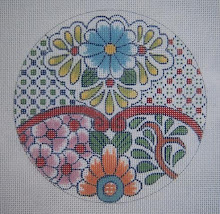 Working on these again, I know now why I didn't start on this beautiful thing when I bought it over ten years ago. I hadn't yet discovered the Kreinik 002V braid, nor had I started using so many beads within the fabric of the needlepoint.
Working on these again, I know now why I didn't start on this beautiful thing when I bought it over ten years ago. I hadn't yet discovered the Kreinik 002V braid, nor had I started using so many beads within the fabric of the needlepoint.I had to have it, as it is so fine in design, color, and painting, but just couldn't quite figure out what to do with it. Thirty five years ago, I would only have had wool or cotton for it, and no metallic. YUK. Anyway, this is the sort of canvas I enjoy so very much, as it never gets boring - there are so many areas to skip to when I tire of one, and it's fascinating to watch it develop and come to life.
As I have shown this canvas before I started stitching - we'll start here. You can see where I marked the dots for placement of the beads - and am just working basketweave around them. (silk on this one, as I already had the colors - some of my favorites.)
The next picture is a detail of the gold outlining - it's quite striking! This is an example of why I never get bored with a canvas like this one. Always something else to do on it when I tire of one activity. It's exciting, after getting an area outlined, to go ahead and stitch in the color - and move on to another area and do the same thing.
 Outlining has never been my favorite thing to do, although my sister enjoyed it a lot - more challenge, she said.. I prefer the mindless activity of background and other design areas of basketweave. What will keep me going on the gold on this, is, for example, that beautiful area on the lower right where I'll fill in all those yummy colors that blend into each other.
Outlining has never been my favorite thing to do, although my sister enjoyed it a lot - more challenge, she said.. I prefer the mindless activity of background and other design areas of basketweave. What will keep me going on the gold on this, is, for example, that beautiful area on the lower right where I'll fill in all those yummy colors that blend into each other.
And now the beads!! This water effect would have been too plain just worked in basketweave, but the canvas absolutely would not tolerate textured decorative stitches - would be an eye shattering mess to do that. By using these clear beads, applied with floss in the background colors, it has just enough surface texture to be interesting. Beads in the same colors as the background areas would be too much. This way, the effect is subtle, and it just looks like a bit of sparkle on the surface of the water. (my favorites, of course, Sundance #250.)
 I have no restraint when it comes to Mindy's designs, so decided I could have one more - justified, of course, by the fact that I'll probably show them in a future article for Needlepoint Now - being optomistic that I'll finish all three I now have.
I have no restraint when it comes to Mindy's designs, so decided I could have one more - justified, of course, by the fact that I'll probably show them in a future article for Needlepoint Now - being optomistic that I'll finish all three I now have.
This will be worked the same way, as it's very busy in pattern - the clear beads on the flowers, and cotton floss on the background. Kreinik metallic braid #032 will be the outline, as it's white, and the sparkle is needed, I think.
The DMC colors are absolutely beautiful for this. The matte of the thread will also show up the beads well, and let them shine. As I had no sillks in my stash in these colors, I was able to get all new threads in cotton for it, which was my original preference anyway.
Please do go to Mindy's web page and see her other fine things. I didn't realize it until I spoke with her, but she has been around as long as I have - close to 40 years, and has her own store, as well as her wholesale to shops around the country. See her at Mindy's Needlepoint Factory.
Also, if you haven't used beads on the painted canvas yet, I have put my original book on Beads! into two chapters under e-patterns (to download and print out) on my web page. This method is so simple, and something I really enjoy doing - not at all complicated.
The book itself has also been revised to include both chapters and the variety of projects I 've done since it was first printed - and lots and lots of colored pictures. You can see it on Elegant Whimsies.
 Anne Stradal (The Cape Stitcher) has now finished this beautfiul lighthouse, and as always, gives a simple but detailed explanation of why she chose which threads and stitches. She is a master at this, and never suffocates a canvas with too much.
Anne Stradal (The Cape Stitcher) has now finished this beautfiul lighthouse, and as always, gives a simple but detailed explanation of why she chose which threads and stitches. She is a master at this, and never suffocates a canvas with too much. 














































